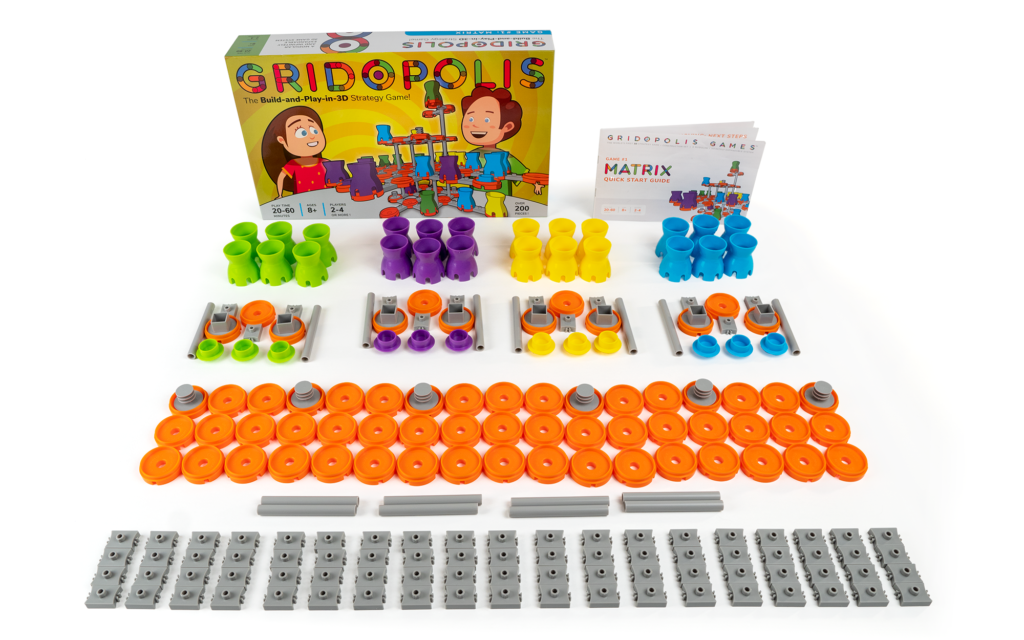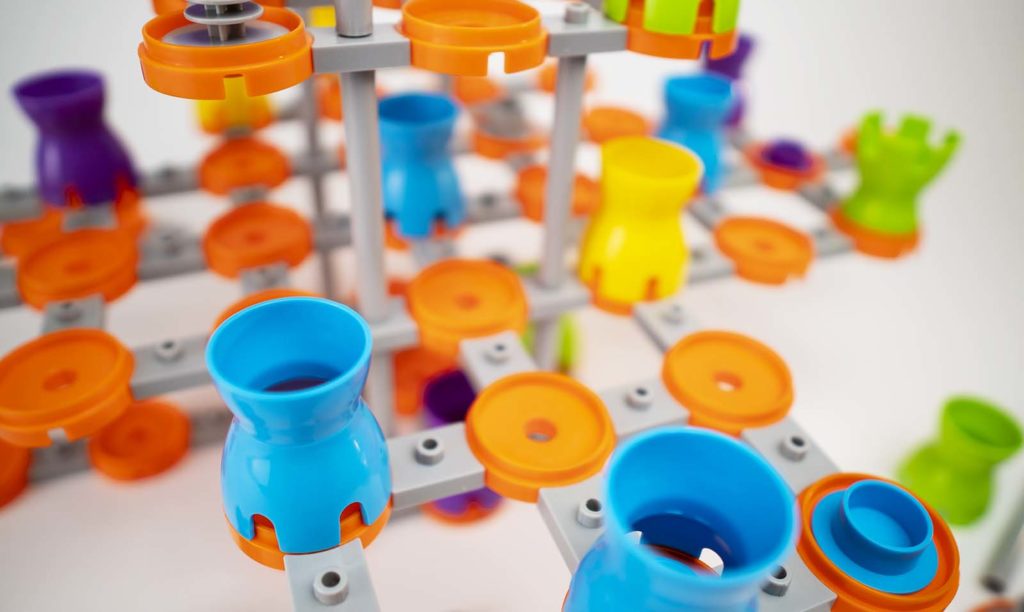My business/economics college class was dry on occasion, but there were times that I enjoyed the projects that the professor handed out. One such project was to create a business and being relatively good at “Chess”, I decided to invent a 3D/4D computerized chess set. We didn’t have to actually make the product, just the PowerPoint. The gaming community and our level of technology isn’t exactly ready for 4D Chess, though I have seen 3D renditions throughout the years.
“Matrix” is but one of the “blueprints” available for “Gridopolis”, a gaming system that’ll be seeking funding through Kickstarter in July 2019. “Matrix”, the original grid-set design, is like 3D “Chess/Checkers” but with an adjustable playing grid. To keep things simple I’ll be opting to focus on the “Matrix” ruleset in this article.
Before we begin it’s worth noting that the copy I received is a prototype, meaning that it is not fully representative of the final product. More specifically, “the creator developed 500 first edition boxes last year for the purposes of sending to folks like you in preparation for the KS.” It goes without saying that everything you’ll read and see about here is subject to change. I am also required by FCC regulations to disclose that I was paid to cover this game, however my thoughts and opinions are my own.

First and foremost, the prototype box was fairly large…reminding me of my “Hero Quest” days where game boxes were the size of Mack trucks. This game box kind of has to be though, considering that it comes with a number of medium to large-sized components. We’re not talking meeples, dice, and some cards. We’re talking shot glass sized plastic player pieces, poles, pads, and a number of other components that will fill up plenty of space on your gaming table. The game itself supports 2-4 players, is appropriate for ages 8+, and has an average play time of 20-60 minutes.
As far as setting up, the manual has a suggested layout for the pads, poles, kingerizers (home pad), and hyper-pads depending on the number of players. Each player will receive two posts, two blocker boxes, and three pads w/ links…these are set aside for later use. Each player gets six markers and will place three on their home-row and three in front of those three in horizontal lines. The markers will be placed castle side down to indicate their pawn status. Should a marker ever reach an opponent’s home-row, they’ll be flipped to their king side allowing them to move twice AND backwards.
So what’s a kingerizer? What’s a hyper-pad? How about blocker boxes?

A kingerizer is a fancy name for a home pad that forms a player’s home row. Players start with some of their pawn markers on these spaces. As mentioned above, pawns can be flipped to kings should they ever reach their opponent’s home row (any of their kingerizer spaces). A hyper-pad allows a player to teleport from one pad to another. They must teleport if able when landing on one. Lastly, blocker boxes can be placed by players on a basic pad to block movement. It can’t be placed on a kingerizer, hyper-pad, or a pad occupied by a marker. Using a blocker box takes up a player’s current turn, in lieu of a move.
On a player’s turn, they’ll either move a marker, add to the grid with their stock of poles/pads, or place a blocker box.
Pawns move one space forward or sideways, but never backward and they cannot move sideways onto their own home-row spaces. They can jump in a straight line, be it orthogonal or diagonal. They can jump their own piece (no capture) or an enemy piece (capture). Since the game is 3D, it’s possible to jump across multiple levels so as long as there are no turns. If a pawn starts at level 3 and want to jump an enemy piece directly below it on level 2, they’ll end up on level 1. Multi-level diagonal jumping works the same way. This MAY cause you to land off the grid, in which case both pieces are removed from play (kamikaze). Kings move twice in one turn. It is possible for a pawn or king to chain jumps like in “Checkers” and this only counts as one move.
Players continue to take turns until only one is left standing, at which point they are the winner. If desired, players can play a timed game and count their score when the time limit expires. The time limit doesn’t matter, so as long as everyone has an equal number of turns when the time runs out.
Editor’s Note: The above doesn’t cover all of the rules found in the manual, but should give you a good idea as to how the game is played.

“Gridopolis: Matrix – Game #1”, known henceforth as “Matrix”, is both a simple yet appealing idea. Yes, it borrows concepts from both “Chess” and “Checkers” and honestly, I’m okay with that considering the developer added other mechanics to set it apart from said games. You won’t find blocker boxes or a modular playing area in “Checkers”, for example. It makes me wonder if the developer will be adding other piece types to the mix down the line…knights or bishops, for example, that move differently than the pawn and king pieces. It would be a missed opportunity, I feel, if that were to never happen.
I applaud the game for challenging a player’s spatial awareness. This comes into play especially when jumping multiple levels. From a top-down perspective it’s easy to where one would land, but that bottom level you’re jumping to may not have a pad on your designated landing spot. What messes me up the most is the multi-level diagonal jumping. I, and I suspect a lot of you, are so used to 2D grid based games that we forget to even consider the option. In the wise words of Yoda, “you must unlearn what you have learned.”
“Matrix” would certainly appeal to the gamer family, especially those who love a good abstract game. The proposed grid design in the rule book is but one of many different starting combinations, and I have a feeling that kids will relish the chance to build crazy designs. The 3-4 player game is a bit more chaotic and there’s more room for kids to gang up on one individual. Such is the burden of games that sport a free-for-all rule set. With more pieces (which I’m sure could be bought separately), larger playing areas can be created to support interesting team variants. Hopefully the developers make such an endeavor affordable, as LEGOs are outrageously priced nowadays.
As mentioned above, “Matrix” is but one of the blueprints available for “Gridopolis”. Through the official website’s download page, you’ll find other blueprints/games and resources to expand the core game. I’m told that there’s a crowd-sourcing project in the works that’ll allow customers to submit their own ideas/games and if accepted, be published on said download page for others to use. I’ll be interested to see what both the developers and the general public come up with.
Kickstarter: http://www.gridopolis.fund/
Website: https://www.gridopolis.games/
